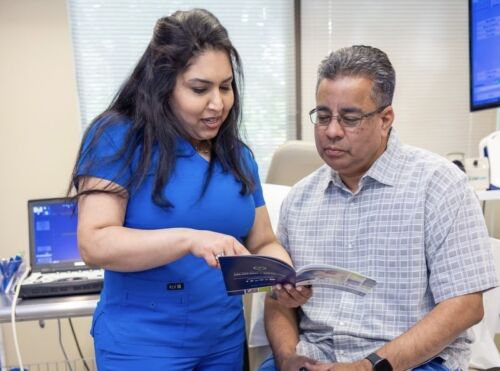The Basics of Compression Stockings
The most important component of a compression stocking is its strength, or how much pressure the stockings exert on the leg. Measured in mmHg (millimeters of mercury), the higher the mmHg number, the stronger the compression stocking.
If you’re looking for over-the-counter compression stockings to reduce swelling and the symptoms of varicose veins, or you’re planning a long plane ride, compression stockings with an mmHg between 15-20 are fine.
Compression stockings at the higher numbers — 20 to 30 mmHg and above — are usually prescribed for varicose veins, recovery from sclerotherapy (a treatment for varicose veins), or to prevent deep vein thrombosis, a blood clot that forms in the leg veins and could travel to the lungs. For prescription-strength compression stockings, a medical professional will measure your leg for a proper fit. Be sure to get your measurements done in the morning, when swelling is less severe.
Pressure is strongest at the ankle and gradually lessens as the stocking goes up the leg. You can buy compression stockings with or without a foot. Cost varies depending upon the strength and type you purchase, but typically cost between $10 to $100 a pair.
The type of compression stockings you need depends on where the swelling is most severe. If the swelling is mostly in the calf, knee-high stockings help control the symptoms of varicose veins. Just be sure to not pull the stockings above the knee; this could lead to the garments slipping down or bunching up, which may make the swelling worse. Swelling that affects the entire leg can be controlled with thigh- or waist-high compression stockings.
Compression stockings can be made of opaque or sheer fabric. Opaque compression stockings are the most common type and provide the most durability and strength. Sheer fabrics are more transparent, but are not as strong as opaque stockings and may easily snag.
Whichever style or strength you select, the stockings should feel snug, but not uncomfortable. The stockings must fit smoothly along the skin, and not gather around the ankle. If the stockings pinch the ankles, they could cut off circulation.
Putting on compression stockings can be difficult at first, but with practice it becomes easier. To start, you can fold the stocking inside out, slip it over your foot, and then slowly roll it up over the entire calf or leg. Some people use a device called a stocking donner to help them put on the item, as well.

 About Vein Disease
About Vein Disease
 Spider Veins
Spider Veins
 Varicose Veins
Varicose Veins
 Vein Disease Treatments
Vein Disease Treatments
 Treating Spider Veins
Treating Spider Veins
 Treating Varicose Veins
Treating Varicose Veins
 About Us
About Us
 Patient Resources
Patient Resources
 Physician Resources
Physician Resources


